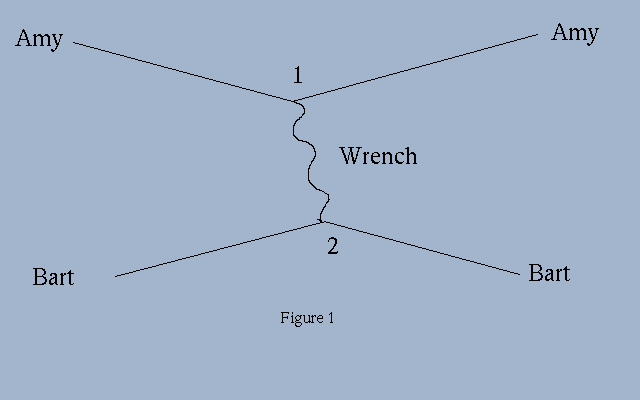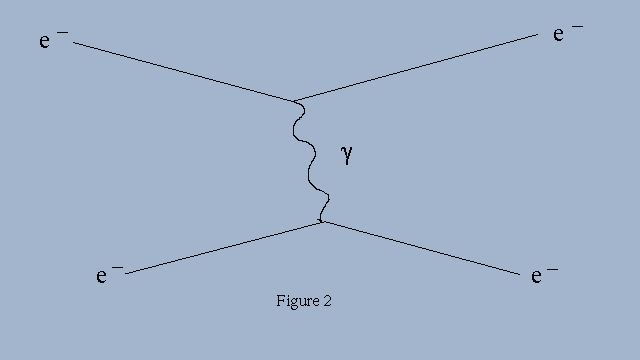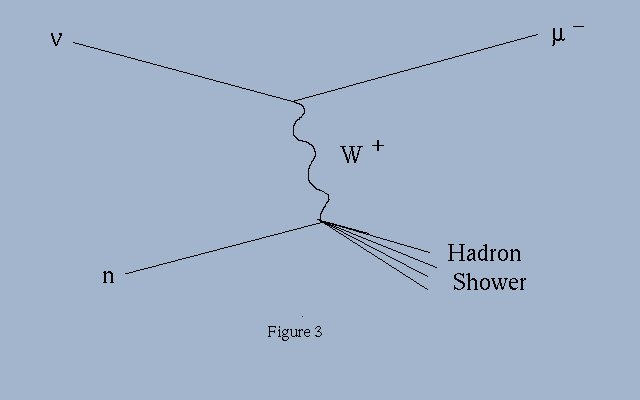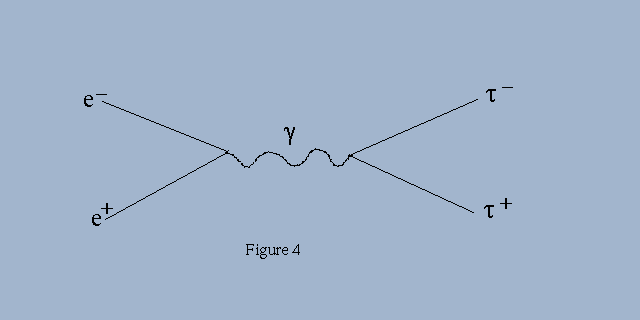
The space shuttle presents an ideal stage on which to illustrate the main idea here, and hopefully all students have seen some video images of astronauts at work in the shuttle's cargo bay. Specifically, the space shuttle, being in free fall through space, is the ideal place to see Newton's first law at work. Objects in motion really do tend to remain in motion at constant velocity when we remove the annoying interference of gravity and air resistance! Here then is the opportunity to demonstrate a force as the exchange of a particle.
Two astronauts, Amy and Bart, working in the cargo bay, have pushed off from one wall, and are drifting at constant velocity down the bay. (See Figure 1) Bart notices that Amy has a nice big wrench, and asks to borrow it. At point 1 in the diagram, A gives the wrench a toss. Since the wrench now has some transverse momentum, and the momentum of the system A + W must be conserved, A's velocity vector must change -- she must acquire some transverse motion in the direction opposite the wrench. At some later time, point 2 in the diagram, B catches the wrench, and now the conservation of momentum for B + W requires B's velocity vector to change. (I've drawn the path of the wrench with a wiggly line because Amy gave it a bit of spin as she tossed it.) Now if you imagine all this taking place in the dark, with A and B each wearing a light, an observer would not see the wrench at all, but instead would see two particles repel each other! The little diagram inside the cargo bay tells us exactly what went on here, and since it does such a fine job of explaining the interaction between two humans, I am going to refer to it as the fine man diagram (pun definitely intended).

From this point, it is easy to replace A and B in the fine man diagram with two particles of like charge, say two electrons, replace the wrench with a photon, and we have the Feynman diagram for a typical electromagnetic interaction (Figure 2). As before, the exchanged particle is shown as a wiggly line. (Richard Feynman, inventor of this handy little diagramming technique, received the Nobel Prize in physics for his work on quantum electrodynamics, the currently accepted theory of electromagnetism.)

Of course the repulsion of two like-charged particles is not the only sort of force in nature - a good thing for us! - but in fact all forces can be thought of in this same way. An immediate question, and one your students will bring up, is how do you explain an attraction, such as that between an electron and a proton. In our analogy we can replace the tossed wrench with an extended pole of some sort, so each astronaut can tug on it. (Not only will the pole be under tension, but the analogy is being stretched pretty taut as well!) The best description of what happens in quantum field theory is that the exchanged particle carries negative momentum - not an easy thing to visualize. The exchanged gauge bosons are in fact all virtual particles, can never be directly observed, and "borrow" momentum from the quantum field, subject only to the limitations of the Heisenberg Uncertainty relation. (Real, observable versions of these bosons can also exist, but they no longer mediate forces. The real photon becomes the quantum of light, for instance.)
Of course this is only the beginning of the usefulness of Feynman diagrams; they permeate high energy physics today, and it is hard to imagine discussing particle interactions without them. To whet your appetite I will show you one more diagram, that illustrates one type of deep inelastic neutrino scattering. Figure 3 illustrates a "charged current interaction" between a muon neutrino and a neucleon (proton or neutron). The incoming neutrino produces a W boson and turns into a muon! The W interacts with a quark in the neucleon and blows it to bits (that's what inelastic means). The struck quark and the remaining two quarks shower into a variety of hadrons, dissapating the large amount of energy that the W carried (that's what deep means).

It was not just by chance that I chose to show you this last Feynman diagram. This is a particle interaction that is near and dear to me! It is one of the neutrino interactions that we are looking for at NuTeV.
Well, I really intended that to be the end of this little article, then yesterday (10/11/95) it was announced that two high energy physicists, Fred Reines and Martin Perl, will receive this year's Nobel Prize for Physics. Reines, along with the late Clyde Cowan was one of the first to observe neutrino interactions, in 1953. Perl was the leader of a team that discovered the Tau particle. (The tau is the third, and most massive of the charged leptons, the others being the electron and the muon.)Here is Perl's interaction:

An electron and its anti-matter counterpart, the positron, collide at high energy. They annihilate, and the energy is carried off as a photon, which may then produce another pair of particles, in this case the "tau plus" and "tau minus". The particles thus produced are always a particle-antiparticle pair, and this process is called "pair production".
One of my colleagues has suggested a macro-anology for this sort of diagram. Imagine a pair of ice dancers skating toward one another. As they meet, one scoops the other up, and they travel as one "particle" for a while, then separate again. Of course they usually separate into the original particles, whereas here we have two entirely different particles at the end of the process. I guess that is why I find physics so much more interesting than ice dancing!
I must point out here that if I rotate Figure 4 90 degrees, it will look much like Figure 2; that is, it will look like an electron and a tau exchanging a photon and repelling each other. The calculations underlying each of these diagrams would be identical, even though by rotating I have in a sense exchanged space for time. Also, something funny is going on with the electric charge -- I would no longer see any antiparticles, since charge must be conserved. This has led physicists to sometimes describe an antiparticle as a particle going backwards in time.